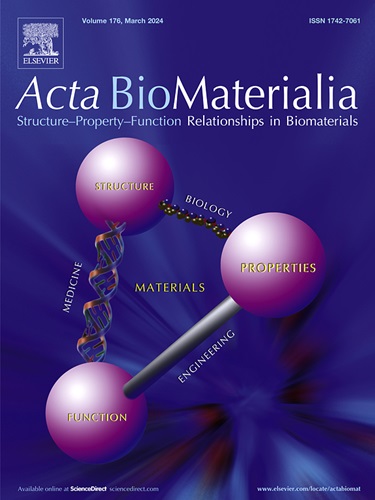微模式化的细胞隔离诱导癌症相关成纤维细胞的表型改变。
IF 9.4
1区 医学
Q1 ENGINEERING, BIOMEDICAL
引用次数: 0
摘要
单细胞研究的最新进展揭示了癌症相关成纤维细胞(CAFs)的巨大转录组异质性,每个亚群可能在肿瘤微环境中具有独特的作用。然而,目前尚不清楚不同的CAF亚群应该如何在体外培养以重现其体内表型。CAF固有的可塑性,即它们在不同环境刺激下动态改变表型的能力,使得在体外诱导和维持特定的CAF状态极具挑战性。在这项研究中,我们研究了细胞形状和限制在不同刚度的二维培养基质上对CAF转录组谱和表型的影响。利用聚丙烯酰胺水凝胶的微图型诱导细胞形态的形状和限制依赖性变化,我们观察到微图型CAF表现出向更多的结缔组织增生和炎症性CAF亚群的表型转变。此外,微模式还可以控制一系列的caf特异性标记物和通路。最后,我们报告了微图案和非微图案的CAF对抗癌药物的不同反应,强调了考虑CAF可塑性和调节网络的表型导向治疗的重要性。对CAF形态的控制为在体外建立高度稳健的CAF表型提供了一个独特的机会,有助于更深入地了解CAF的可塑性、异质性和开发新的治疗靶点。意义声明:癌症相关成纤维细胞(CAFs)是许多癌症中主要的基质细胞类型,最近的研究表明它们是高度异质性的,包括几个亚群。目前尚不清楚不同的caf亚群应该如何在体外培养以重现其体内表型。在这项研究中,我们研究了细胞形状和限制如何影响CAF转录组谱和表型。我们报道,微模式CAF类似于在体内观察到的结缔组织增生和炎性CAF亚群,与非模式CAF相比,对抗癌药物的反应不同。对CAF形态的控制可以在体外产生高度稳健的CAF表型,从而有助于更深入地了解CAF的可塑性和异质性。本文章由计算机程序翻译,如有差异,请以英文原文为准。

Cell confinement by micropatterning induces phenotypic changes in cancer-associated fibroblasts
Recent advances in single-cell studies have revealed the vast transcriptomic heterogeneity of cancer-associated fibroblasts (CAFs), with each subset likely having unique roles in the tumor microenvironment. However, it is still unclear how different CAF subsets should be cultured in vitro to recapitulate their in vivo phenotype. The inherent plasticity of CAFs, or their ability to dynamically change their phenotype in response to different environmental stimuli, makes it highly challenging to induce and maintain a specific CAF state in vitro. In this study, we investigated how cell shape and confinement on two-dimensional culture substrates with different stiffnesses influence CAF transcriptomic profile and phenotype. Using micropatterning of polyacrylamide hydrogels to induce shape- and confinement-dependent changes in cell morphology, we observed that micropatterned CAFs exhibited phenotypic shifts towards more desmoplastic and inflammatory CAF subsets. Additionally, micropatterning enabled control over a range of CAF-specific markers and pathways. Lastly, we report how micropatterned and non-micropatterned CAFs respond differently to anti-cancer drugs, highlighting the importance of phenotype-oriented therapy that considers for CAF plasticity and regulatory networks. Control over CAF morphology offers a unique opportunity to establish highly robust CAF phenotypes in vitro, facilitating deeper understanding of CAF plasticity, heterogeneity, and development of novel therapeutic targets.
Statement of significance
Cancer-associated fibroblasts (CAFs) are the dominant stromal cell type in many cancers, and recent studies have revealed that they are highly heterogeneous and comprise several subpopulations. It is still unclear how different subsets of CAFs should be cultured in vitro to recapitulate their in vivo phenotype. In this study, we investigated how cell shape and confinement affect CAF transcriptomic profile and phenotype. We report that micropatterned CAFs resemble desmoplastic and inflammatory CAF subsets observed in vivo and respond differently to anti-cancer drugs as compared to non-patterned CAFs. Control over CAF morphology enables the generation of highly robust CAF phenotypes in vitro, facilitating deeper understanding of CAF plasticity and heterogeneity.
求助全文
通过发布文献求助,成功后即可免费获取论文全文。
去求助
来源期刊

Acta Biomaterialia
工程技术-材料科学:生物材料
CiteScore
16.80
自引率
3.10%
发文量
776
审稿时长
30 days
期刊介绍:
Acta Biomaterialia is a monthly peer-reviewed scientific journal published by Elsevier. The journal was established in January 2005. The editor-in-chief is W.R. Wagner (University of Pittsburgh). The journal covers research in biomaterials science, including the interrelationship of biomaterial structure and function from macroscale to nanoscale. Topical coverage includes biomedical and biocompatible materials.
 求助内容:
求助内容: 应助结果提醒方式:
应助结果提醒方式:


